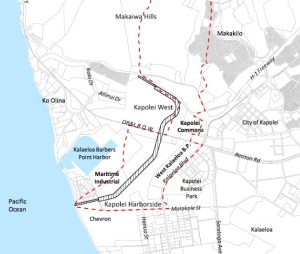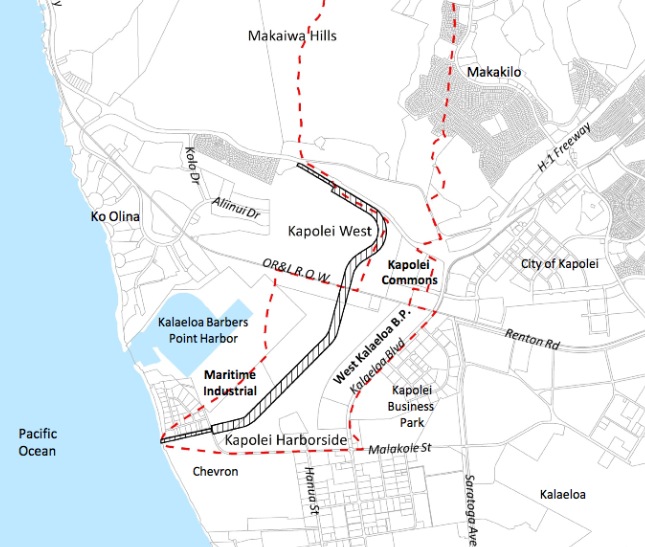
A concrete drainage outlet in West Kapolei proposed and approved by government agencies more than two decades ago — but never built — is undergoing closer scrutiny as its developer seeks to obtain again all of the project’s permits that have long since expired. Although the City and County of Honolulu has approved new Special Management Area and shoreline setback variance permits, the U.S. Army Corps of Engineers determined earlier this year that the project’s application for a permit from that agency was incomplete. And in July, the project, which would serve as the main stormwater runoff outfall for the entire 2,700-acre drainage basin, hit another snag: The state Department of Land and Natural Resources’ Office of Conservation and Coastal Lands (OCCL) chose not to support a Conservation District Use Permit. Rather than face rejection before the state Board of Land and Natural Resources, the developer, `Aina Nui Corporation, withdrew its application.
OCCL staff says the company, an affiliate of the James Campbell Company, LLC, will likely reapply. But unless the application includes a thorough analysis of potential impacts to native Hawaiian cultural practices and of alternatives, the agency will likely stick to its recommendation that the Land Board deny the permit.
The drainage outlet was originally proposed by the Estate of James Campbell in the early 1990s. It received approval from Honolulu’s Department of General Planning in 1993 and from the Land Board in 1994.
The 1,750-foot-long drainage canal was intended, first and foremost, to serve the Kapolei Business-Industrial Park, a planned 931-acre extension of the James Campbell Industrial Park. The expansion was expected to increase runoff in the area and exacerbate flooding in low-lying areas near the Kalaeloa Boulevard/Malakole Road intersection and near the northwest corner of the Chevron USA refinery. The outlet was designed to help alleviate that flooding and also to serve future developments within the that includes the Awanui Gulch, Palailai Gulch, and Makaiwa Gulch watersheds.
`Aina Nui proposes to dredge the outlet through a fossil reef located on state unencumbered land, but it needs a CDUP before it can obtain a lease or easement from the DLNR. Once the outlet and the mauka canal that feeds into it are complete, the company plans to dedicate them both to the city.
In its 2011 environmental assessment for the outlet, the company states that the project “is an essential component to continuing the successful expansion of Kapolei as O`ahu’s second urban center.” The outlet would serve several planned developments, including Makaiwa Hills, Kapolei West, Kapolei Harborside, Kapolei Commons, West Kalaeloa Business Park, and the Kapolei Maritime Industrial project, the project’s draft EA states.
While acknowledging the need for the project, OCCL staff stated in its July 25 submittal to the Land Board that it was concerned about the long-term effects on the marine environment.
“The drainage canal traverses an industrial area, including an oil refinery, and would drain a major urban watershed. The [final environmental assessment] for the project provides marine and archaeological assessments, including storm water flow modeling and marine plume modeling (more or less based on the studies in the 1991 FEIS, with some updates), but the FEA concludes that the project will have No Significant Impact. … [W]e are not convinced that the 1991 FEIS and the current FEA provide adequate information, disclosure, and mitigation measures from which to conclude that the project is consistent with Conservation District objectives to protect and conserve the natural and cultural resources of the state for present and future generations,” the submittal states, later adding that “[t]he focused discharge of runoff into nearshore waters will result in a high potential for pollutants from the watershed to be introduced into the marine environment.”
The OCCL also seemed unimpressed with `Aina Nui’s investigation into alternative stormwater control options.
“[T]he original FEIS from 1991 devotes a paltry two pages to a discussion of alternatives,” the submittal stated.
Those alternatives include diverting runoff into Kalaeloa Barbers Point Harbor or into an existing drainage channel near the Barbers Point Naval Air Station, or retaining runoff in retention basins.
The 2011 EA dismissed the harbor alternative because the velocity of discharge might affect the maneuvering of vessels or dislodge ships from their moorings. Discharging into the existing drainage channel east of the project area was also deemed infeasible because it’s too small to take more runoff from the West Kapolei drainage area. That channel already serves a separate 2,500-acre drainage basin and can’t be widened or deepened because of surrounding development and the area’s hydrology, the EA stated. Finally, with regard to retention basins, the EA found that they are impractical because they take up too much space.
Because the proposed drainage outlet could significantly affect the Conservation District, the OCCL stated that there should have been a more thorough investigation of alternatives.
With regard to the potential impact of the outlet on native Hawaiian rights, the OCCL wrote that `Aina Nui had included only a short discussion on the subject in its CDUP application and did not appear to have interviewed any native Hawaiian cultural practitioners
“Because this is a major project with long-term effects, it would be important to consider whether native Hawaiian interests were being protected. Unfortunately, the Ka Pa`akai analysis appears to be superficial,” the OCCL stated. (The “Ka Pa`akai analysis” refers to the Hawai`i Supreme Court case Ka Pa`akai O Ka `Aina vs. Land Use Commission, which laid out the framework by which government agencies must identify the extent to which traditional and customary native Hawaiian practices are affected by a proposed action and also identify actions necessary to protect native Hawaiian rights.)
— T.D.


Leave a Reply